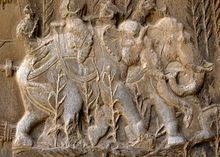Persian war elephants


The men (excluding the driver) sat in a large tower from which troops would fight. The elephant itself would normally be armed with thin plate armour (the Sassanids used chain mail as well as thin plate armour) and would bear a large crenelated wooden howdah on its back.[1] Persian war elephants were trained by their rider, called a mahout, who would also ride the elephant into battle. While on the move, the elephants required large paths to cut to accommodate their passage. Training elephants was a difficult task and their upkeep was expensive because of their high nutritional demands. [citation needed]
History
Under the Achaemenids
Persians used
Some[ mention war elephants in their accounts of these earlier campaigns.
Under the Parthians
Since the early 1st century AD, elephants were also used as a symbol of kingship in Iran. This notion was adopted from the
Under the Sasanians

In the early Sasanian period, the war elephants were used in battles as a psychological weapon for its terrorizing effects. Later this role evolved into a logistical one, and in late Sasanian period they were used by army commanders to survey the battle scene.[2]
Sasanian elephants were under a special chief, known as the Zend−hapet, or "Commander of the Indians", as they were from India.

| Military of the Sasanian Empire |
|---|
| Armed forces and units |
| Ranks |
| Defense lines |
|
| Conflicts |
|
The Sasanian elephants were most effective in
Miscellaneous applications of the elephants by the Sasanians are also reported; Agathias mentions their use to blockade a river in one occasion.[3]
In the
Later dynasties
The war elephants were also used by
In popular culture
- Shatranj (chess) – which modern chess has gradually developed from, same as Indian chess, includes the war elephant with the name fil (meaning "elephant" in Persian) as the bishop.
- The Persian civilisation in the real-time strategy computer game Age of Empires II has war elephants as their unique unit, in reference to this period in history. War elephants are also available to the Persians in Age of Empires and are granted fast movement.
See also
- War elephant
- Crushing by elephant
- Sassanid army
- History of elephants in Europe
- List of individual elephants
- Military animals
- Cavalry tactics
References
- .
- ^ .
- ^ a b c d e f g Charles, Michael B. "ELEPHANT ii. In the Sasanian Army – Encyclopaedia Iranica". www.iranicaonline.org.
- ^ Julian, Oration 2: "[[s:The heroic deeds of Constantius|]]"
- ISBN 978-0-8032-6004-7.
- ^ Acta Antiqua Academiae Scientiarum Hungaricae. Akadémiai Kiadó. 2003. p. 369.
- ^ Richard Nelson Frye, The Cambridge History of Iran: The period from the Arab invasion to the Saljuqs, (Cambridge University Press, 1975), 8-9.
- ISBN 9781326233327.
- ^ Kistler, John M. War Elephants, Westport, CT: Praeger, (2006).
Further reading
- Nicolle, David (1996). Sassanian Armies : the Iranian empire early 3rd to mid-7th centuries AD. Montvert. ISBN 1-874101-08-6.
- Rance, Philip (2003). "Elephants in Warfare in Late Antiquity". Acta Antiqua Academiae Scientiarum Hungaricae. 43 (3–4): 355–384. .
- Wilcox, Peter (2001). Rome's Enemies 3: Parthians and Sassanid Persians. Osprey. ISBN 0-85045-688-6.
